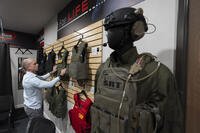My Short D-Day
"I walked up and tapped 'Doc' on the shoulder. He looked as though he was seeing a ghost. ..."
Contributed by Bill Hamlin, Air Force.
I was a pilot in the 378 Fighter Squadron in June of 1944 and we were aware that an invasion was coming but not sure when. On the morning of the sixth, sixteen pilots were ordered to the flight line to sit in our planes and await further orders. We were the backup for the planes flying cover over the beachhead of Normandy, although we were not aware that the Ninth Air Force expected the Luftwaffe to be present in force against the invasion and anticipated heavy casualties. We sat in the sun all day and were finally given a break to eat and catch a few hours sleep. The pilots assigned to the mission were woken up at about 3 a.m. and told to get out to their planes. It was a very dark night with a light rain falling.
When I got to my plane, I found it was red-lined for night flying because of intermittent problems with the instrument lights. It was the pilot's decision whether to fly a red-lined plane. The instrument lights were functional and I decided to take a chance since we had waited so long to see the invasion and once I got into formation I would be able to rely on my flight leader's instruments until day break.
As I pulled the lever to retract the wheels after takeoff the instrument lights failed and I was in complete darkness. I opened the canopy and could see no stars and no horizon and no other planes. The instrument panel was equally useless. I kept pressure on the stick to maintain a slight climb aware that if I climbed too fast the wing would stall and I would crash. I was sure that at any moment I would see the exhaust of my leader's engine and be able to join him.
Suddenly I felt a series of sharp blows to my head and then I was surrounded by flames towering over the plane. For a moment the thought crossed my mind, "It's true. There is a Hell and somehow I am there." This thought was replaced by the action of unfastening my seat belt and discarding the oxygen mask and earphones. The next moment I was crawling along the wing and I could feel the fifty caliber ammunition exploding in the wings under my hands and knees.
The flames were in front and behind the wing and would have reached much higher than my head if I had stood up. I did not stand erect until I was off the wing and around the brick silo which had stopped the plane. At that point I unbuckled the leg straps of my parachute, which held the chute and a life raft as a cushion under me. Now that I had time to think I realized that the original fire came when two external gasoline tanks holding 100 gallons of 100 octane gas each had ruptured when the plane hit the ground. There was another 800 gallons in the main and auxiliary tanks, and I decided to move a little further away behind the remnants of the silo. There was plenty of light from the fire now, and I could see the other planes of the Group as they climbed just over the flames on their way to Normandy.
I hung my parachute on a fence and walked back to the fire site. There I saw the flight surgeon and a couple of medics watching the blaze. When I walked up behind them and tapped "Doc" on the shoulder, he looked as though he was seeing a ghost. I am sure they thought I was in the middle of the fire. I probably was not a very pretty sight with blood all over my face and all my hair, eyebrows and lashes burned off but thanks to shoulder straps and seat belt, which gave me a huge bruise from [the] top of my shoulders to my waist, I had stayed conscious and alert enough to escape the fire.
After recovery I flew several more missions but had another crash after an engine failed in the landing pattern at a field in France and was grounded after 37 missions. I spent the rest of the war as a convoy officer and platoon leader in a truck company hauling aviation gas across France and Belgium.
Want to Know More About the Military?
Be sure to get the latest news about the U.S. military, as well as critical info about how to join and all the benefits of service. Subscribe to Military.com and receive customized updates delivered straight to your inbox.















